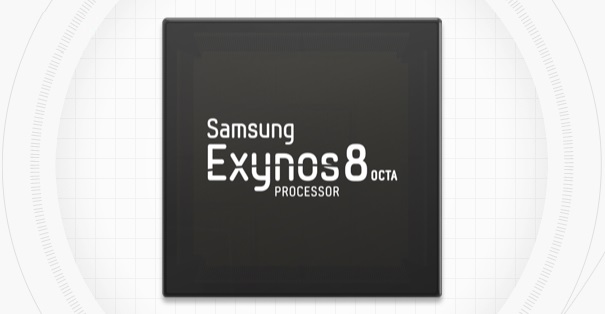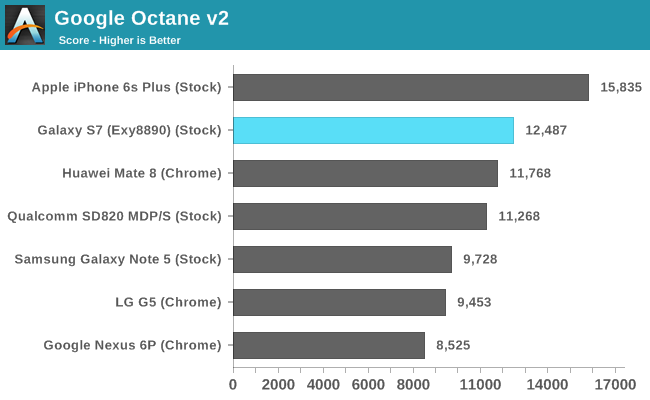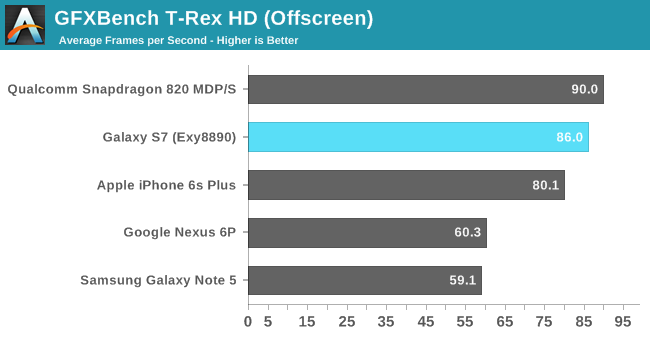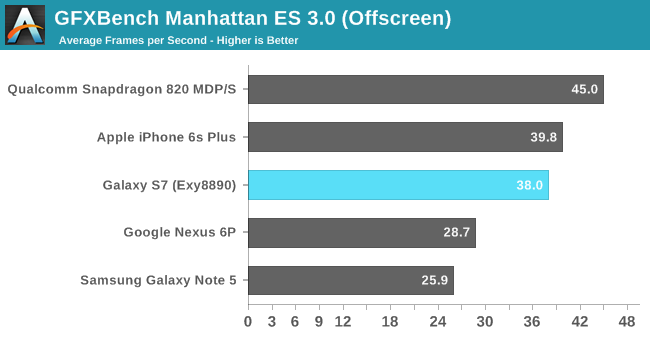Early Exynos 8890 Impressions And Full Specifications
by Andrei Frumusanu on February 21, 2016 6:15 PM EST- Posted in
- Smartphones
- Mobile
- SoCs
- Exynos 8890
- Exynos M1
- Samsung Galaxy S7

| High-End SoCs Specifications | |||
| SoC | Snapdragon 820 | Exynos 8890 | Exynos 7420 |
| CPU | 2x Kryo@1.593GHz 2x Kryo@2.150GHz |
4x A53@1.586GHz 4x Exynos M1 @ 2.60GHz (1-2 core load) 2.29GHz (3-4 core load) |
4x A53@1.50GHz 4x A57@2.1GHz |
| Memory Controller |
2x 32-bit LPDDR4 @ 1803MHz 28.8GB/s b/w |
2x 32-bit LPDDR4 @ 1794MHz 28.7GB/s b/w |
2x 32-bit LPDDR4 @ 1555MHz 24.8GB/s b/w |
| GPU | Adreno 530 @ 624MHz |
Mali T880MP12 @ 650MHz |
Mali T770MP8 @ 770MHz |
| Mfc. Process |
Samsung 14nm LPP |
Samsung 14nm LPP |
Samsung 14nm LPE |
The Exynos 8890 employs Samsung's own designed Exynos M1 cores. The micro-architecture at a high level resembles ARM's big cores, but Samsung seems to have made quite a few changes and improvements when compared to ARM's designs. While by now I do have a quite good idea of what the Exynos M1 looks like, we'll be covering the topic more in-depth in a future article once we'll be able to gain better insight from our own unit for proper benchmarking and power measurements.
On the CPU side we find an 8-core SoC composed of 4x Cortex A53 cores running at up to 1.586GHz coupled with 4x Exynos M1 cores in a big.LITTLE configuration. The most surprising revelation was the fact that the M1 cores reach an extremely high clock of up to 2.6GHz. This represents quite a significant boost over some past rumors which had put expectations 2.3-2.4GHz maximum frequency range. The catch here is that the Galaxy S7's power management doesn't allow all four cores to run at this high frequency but rather only enables the maximum clock when there's at most 2 cores loaded. If there are 3 or more cores under high load, the CPU frequency doesn't surpass 2288MHz.
On the GPU side we knew that we'd encounter a new ARM Mali T880MP12 - the currently largest Mali implementation available among existing SoCs. Back in November I theorized that Samsung would use the larger core implementation to lower the clocks of the GPU block and thus achieve better power efficiency. Indeed that's what seems to have happened as the Exynos 8890's GPU peaks at 650MHz versus the 770MHz frequency for the Exynos 7420. Hopefully this means that the new SoC will be able to maintain its peak performance for longer periods of time.


While I didn't have the time to run too many benchmarks, I did manage to run a few of our basic browser tests as well as GFXBench. We haven't had the opportunity to benchmark the Snapdragon 820 Galaxy S7 yet, therefore I included the score numbers of the MDP/S platform to represent a best-case scenario for the Snapdragon 820 until we can get apples-to-apples scores based on Samsung's browser. This still mostly due to the fact that Chrome is seemingly not yet optimized to take advantage of Kryo's new architecture, and as a result scores some rather mediocre numbers, as seen in some preliminary LG G5 numbers included in the graphs above.


Some quick GPU benchmarks also put the Exynos 8890 slightly behind the Snapdragon 820 in the MDP/S. We will still have to see if actual Snapdragon 820 devices are able to deliver the same performance as the MDP/S platform as there might be some thermal limitations coming into play. Again, we can't comment too much on the scores before we get to know each device's long-term performance and if the attained numbers are sustainable for long periods of time.
One observation I made today which was particularly concerning, was that both with the Snapdragon 820 LG G5 as well as the Exynos 8890 Galaxy S7 got considerably warm after running some heavy workloads. The fact that the Galaxy S7 touts having a heat-pipe thermal dissipation system is a quite worrying characteristic of the phone and should in no way be seen as a positive feature as it points to high power draw figures on the part of the SoC.
The first impression is that the performance difference between the Snapdragon 820 and the Exynos 8890 doesn't seem to be very large, therefore it will be the SoC's power draws and power efficiencies which will determine if, and which one of both will represent a superior design. Hopefully in the coming weeks and months we'll be able to get a better understanding of this new generation of SoCs so that we can paint a definitive picture of the current status of the mobile SoC space.










94 Comments
View All Comments
extide - Monday, February 22, 2016 - link
Why do you think the MP12 will throttle hard? If anything it will throttle less than the MP8 in the 7420, better process, lower clocks, etc will make it produce less power. Running at lower clockspeed is more efficient because you get to lower voltage. They specifically widened it out so they could run it more efficiently so that it would NOT throttle.jjj - Monday, February 22, 2016 - link
The Exynos 7420 is using an older gen GPU and a direct comparison is not ideal. MPX means X cores, just saying to make sure you know that.The Exynos 7420 was dropping in perf some 50%. and was T760MP8 on 14LPE. Here you got T880MP12 on 14LPP and the process is just a bit better.
We do know that Huawei has T880MP4 at 900MHz on 16ff+ so 3 times smaller GPU at 38% higher clocks and it throttles very little. We could do some math based on that but that would mean that we are assuming the same TDP for all else and all else is using quite a lot of power and with diff cores and diff clocks we just can't assume that all else will be equal.The max TDP of the device will likely differ too, the S7 does have a heatpipe.
All in all it is pretty hard to be sure how much it will throttle, the CPU and memory controller will matter a lot but it is very likely that there will be some hard throttling , i hope not more than 40% but maybe with some luck it's 30%. Mali T880 does have some neat memory bandwidth saving feature and ,in theory, they could do a better job than in the past at managing the CPU during gaming.
The past and this remark here that the LG G5 and the S7 do get rather hot are not good signs.
tuxRoller - Monday, February 22, 2016 - link
Why do you hope that the adreno 530 will have 40% lower perf?jjj - Monday, February 22, 2016 - link
Hope Adreno 530 throttles some 40% and not more, guess my phrasing wasn't ideal.After last year i'm happy if it's only 40%..
Additionally, i see the resulting perf as ok for 1440p in actual gaming, not 60FPS but at least above 30FPS and significantly better than what the Exynos 7420 delivered last year.. If the throttling would be more than 40% it wouldn't be much fun.
I am just being cautious and keeping my expectations low.
tuxRoller - Tuesday, February 23, 2016 - link
That's quite reasonable.We'll have to see what arch changes they made (I don't think they were significant based on a quick look at the freedreno drm) and if the new node is enough to offset the greater performance.
alex3run - Thursday, February 25, 2016 - link
These benchmarks mean nothing. When I bought Note 4 it gave twice the ONscreen score of my previous phone GS4. But when it came to games... I was just surprised to see GS4 suprassing a lot faster Note on paper.So let's see games.
N Zaljov - Monday, February 22, 2016 - link
Thanks for the short but informative Exynos 8 warp up, Andrei!Another question (although nobody except me will seriously care about it): Do you know the exact kernel-version used for the Exynos 8890 BSP?
All i do know, is that Qualcomm relies on 3.18.20 for their msm8996 BSP.
N Zaljov - Monday, February 22, 2016 - link
*wrap up. This is my first comment and I'm already mistyping stuff. Mea culpa.Andrei Frumusanu - Monday, February 22, 2016 - link
It was running 3.18.14.N Zaljov - Monday, February 22, 2016 - link
Thanks for the reply.I'm looking forward to your in-depth review of the Exynos 8890. Hopefully, my "test-dummy" is gonna arrive soon.